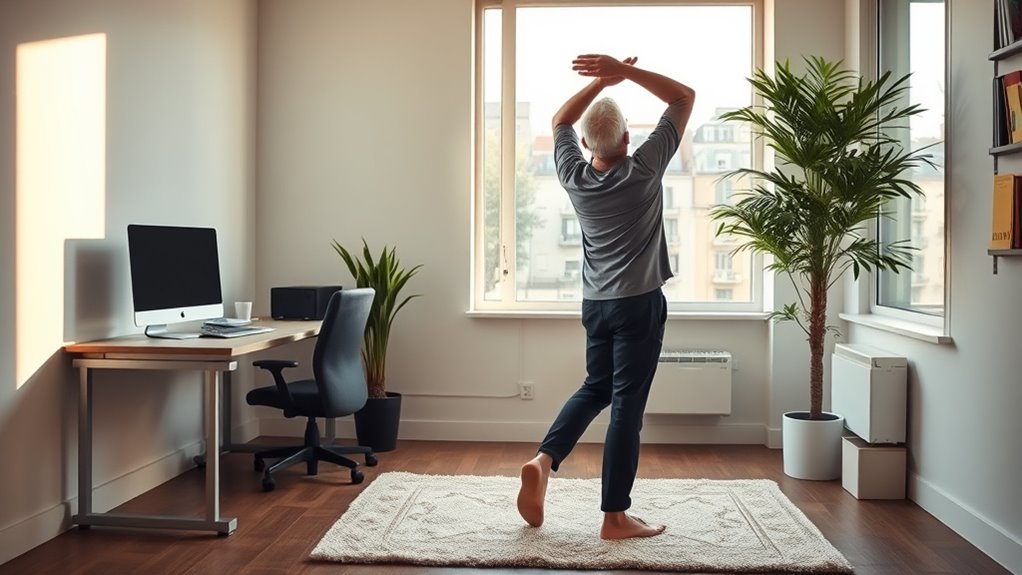To keep comfortable and prevent stiffness, try a simple 10-minute desk stretching routine. Start with neck tilts, shoulder rolls, and seated spinal twists to loosen tight muscles. Include deep breaths to maximize relaxation. Focus on gentle, effective stretches that don’t need special equipment, holding each for about 15 seconds. Incorporate these quick movements regularly to boost circulation and ease tension. Keep going to discover more stretches that can make your workday more comfortable.
Key Takeaways
- Incorporate neck tilts, shoulder rolls, and seated spinal twists to target common areas of tension.
- Allocate specific 1-minute intervals for each stretch to ensure a comprehensive 10-minute routine.
- Use deep breathing techniques during each stretch to enhance relaxation and improve circulation.
- Focus on maintaining proper posture during stretches to maximize benefits and prevent strain.
- Schedule regular breaks and set reminders to make stretching a consistent part of your workday.

Do you often feel stiff or sore after hours at your desk? If so, you’re not alone. Many desk workers experience muscle tightness and discomfort, which can lead to longer-term health issues if neglected. Incorporating simple stretching routines into your day can make a significant difference. But before diving into stretches, it’s essential to guarantee your workspace promotes good posture and comfort. Using ergonomic accessories like adjustable chairs, lumbar support cushions, and monitor stands can help align your body properly and reduce strain. Workplace awareness is key—being mindful of your posture and making small adjustments throughout the day can prevent many common problems. When your workspace supports your body, stretching becomes even more effective because you’re addressing the root causes of discomfort.
A quick, deliberate focus on ergonomic accessories sets the foundation for a healthier work routine. For example, an ergonomic chair with proper lumbar support encourages you to sit upright, reducing lower back pain. An ergonomic keyboard and mouse can lessen wrist strain, and a monitor positioned at eye level prevents neck tension. When your workspace is optimized, stretching exercises target the muscles that tend to tighten from prolonged sitting. You’ll find that these stretches are more effective, as they complement the ergonomic setup rather than fight against poor posture. Additionally, incorporating space and organization strategies can create a calmer environment that promotes focus and reduces mental fatigue, making frequent stretching easier to remember and more effective.
Now, it’s a good idea to develop a workplace awareness that prompts you to stretch regularly. Set reminders on your phone or computer to take a quick break every hour. These regular intervals prevent muscles from becoming stiff and maintain circulation. When it’s time to stretch, focus on movements that loosen your neck, shoulders, back, and hips. Simple neck tilts, shoulder rolls, and seated spinal twists can all be done right at your desk, without any special equipment. Remember to breathe deeply and hold each stretch for about 15 seconds for maximum benefit. This routine doesn’t need to take more than a few minutes but offers a substantial payoff in comfort and productivity.
Frequently Asked Questions
Can Stretching Reduce the Risk of Repetitive Strain Injuries?
Yes, stretching can reduce your risk of repetitive strain injuries by improving muscle flexibility and promoting ergonomic benefits. When you stretch regularly, you keep muscles loose and better aligned, which helps prevent strain from prolonged sitting and repetitive movements. Incorporating a quick, daily stretching routine enhances your overall posture and reduces tension, making it easier to avoid injuries caused by repetitive tasks at your desk.
Is It Safe to Stretch During Work Hours?
Sure, it’s safe to stretch during work hours—if you do it right. Surprisingly, a quick stretch offers ergonomic benefits and mental relaxation, helping prevent stiffness and boost focus. Just avoid bouncing or overstretching, and listen to your body. Incorporating intentional, gentle movements into your routine not only keeps you safe but also transforms mundane desk time into a moment of rejuvenation, proving that even brief breaks can make a difference.
How Often Should I Stretch at My Desk?
You should stretch at your desk every hour to maintain good office posture and prevent stiffness. Incorporate quick stretches during breaks, especially after ergonomic assessments reveal your posture needs adjustment. Regular stretching helps reduce muscle tension and improves circulation, making it easier to stay comfortable and focused. Keep a consistent schedule, and remember to listen to your body to avoid overexertion.
Are There Stretches Suitable for All Age Groups?
You can find stretches suitable for all age groups, but it’s important to tailor them to fit your needs. Start with age-appropriate stretches, and incorporate senior-friendly routines for older adults. These gentle movements help everyone stay flexible and comfortable at their desks. Remember, what’s good for one person might not be for another, so listen to your body and adapt routines accordingly. It’s a win-win for your well-being.
What Are Signs I Should Stop Stretching Immediately?
You should stop stretching immediately if you experience muscle soreness that worsens or joint pain during the activity. If you feel sharp, stabbing pain or significant discomfort, it’s a sign to pause. Don’t push through pain, as it could lead to injury. Listen to your body, and if symptoms persist after stopping, consider consulting a healthcare professional before continuing with your stretching routine.
Conclusion
Remember, even just 10 minutes of stretching can boost your mood, reduce tension, and improve your focus. You might think you’re too busy, but taking a quick break actually enhances your productivity in the long run. So, don’t let a packed schedule keep you from caring for your body. Incorporate these simple stretches into your day—you’ll feel the difference, and your workday will become much more comfortable and efficient.









